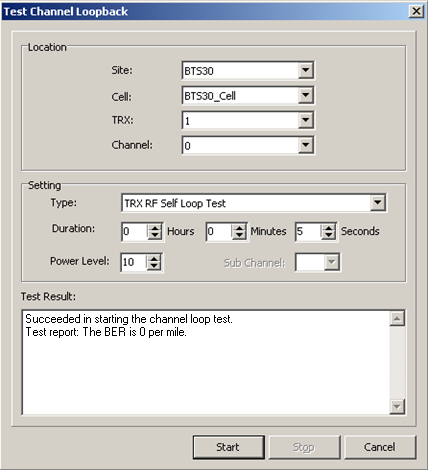This describes how to test the transmission ability of the service channel and speech channel on the LMT. The test includes the BIU Loop Test and TRX RF Self Loop Test of the service channel and the BTS Sound Loop Test and TRX Sound Loop Test of the speech channel.
Prerequisites
- The LMT runs normally.
- The communication between the LMT and the BSC is normal.
- The communication between the BSC and the BTS is normal.
Context
In the case of TRX RF self-loopback test, this channel will affect the TRX (n+5)mod8 of this cell when no frequency hopping occurs. When the RF frequency hopping occurs, the same channel of other TRXs in the same frequency hopping group is affected. The baseband frequency hopping is not supported.
The BTS3001C and the BTS3002C do not support the loop test of the speech channel.
The speech channel loop test needs to be performed during a conversation. Such loop test cannot be performed in the two subchannels of one half rate channel.
BIU loop test
The BIU Loop Test tests the timeslot transmission of the TRX service channel on the BTS DBUS. The TRX sends the service channel data to the service timeslot of the BTS DBUS. After the loopback through the TMU, the TRX receives the data sent by the TRX itself. The TRX compares the data with the original data, and then reports the error ratio to get link quality of the service channel on the BTS DBUS.
TRX RF self loop test
The TRX RF Self Loop Test tests the quality of the RX and TX channels. The TRX RF self loop starts from the DSP, passes the BBU, loops back from the RRU, and then passes the BBU again to come back to the DSP. The DSP then compares the data from the original data to learn the RX and TX channel quality of the BTS.
BTS sound loop test
The BTS Sound Loop Test tests the connection of the TRX speech channel between the Um interface and the BTS DBUS. The TMU loops back the DBUS timeslot of the speech channel to be tested. If the user who occupies a channel can hear his own voice, it indicates that the channel functions normally; otherwise, the channel does not function normally.
TRX sound loop test
The TRX Sound Loop Test tests connection of the TRX speech channel between the Um interface and the DSP. The DSP encodes and then sends the data. If the user who occupies a channel can hear his own voice, it indicates that the channel is connected through; otherwise, the channel is not connected through.
Procedure
- Through GUI
- Through MML
